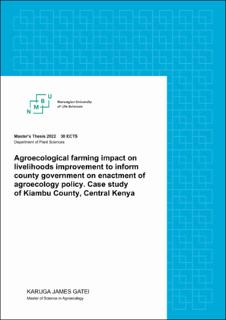| dc.description.abstract | The basis for the recognition, adoption and provision of an agroecology legal framework relies on the capacity of the existing agroecological systems to provide enough evidence on their effectiveness. Policymaking in Kenya is moving towards evidence-based policies; hence for agroecology to be recognized, documentation of its current systems is in need. To support the transition to agroecology and influence agroecology policy adoption, a study was carried out in Kiambu, a county in Central Kenya. The purpose of the study was to document the effectiveness of agroecological practices and use the results in agroecology policy advocacy work. From the study objectives, agroecology principles and dimensions, and opinions of the local agroecological promoters, a set of 16 indicators were used to investigate the effectiveness of agroecology under the five key dimensions: Economy, Health and Nutrition, Environment and Climate Change, Society and Culture, and Governance. According to FAO of the United Nations, the five dimensions are the priority areas for agricultural policymakers and are relevant in evaluating sustainable food systems. Different semi-structured questionnaires for farmers, government extension officers, NGOs field officers and county assembly members were designed to collect data. Farmers interviewed were only from Kiambu, while some agroecology promoters were from outside Kiambu.
Through agroecological farmers networks, women and youth empowerment, knowledge dissemination and sharing increased. A good increase to average increase was recorded on farm productivity, wealth creation, food security, nutrition, mitigation of climate change and environmental conservation. Land size and tenure systems were significant determinants of the type of AEP to be adopted. These positive changes were associated with AEP practices such as diversification, local trading, connectivity, local-based innovations, agroforestry, minimum tillage, integrated pest management (friendly biopesticides, mixed cropping), manuring and biogas production. The study results are consistent with many other practical and theoretical case studies that have mentioned or shown the facilitation of agroecology in improving farmers and the larger community’s livelihood. The ability of agroecology to provide solutions to the above issues is a direct call for its recognition through promotion, the transition of farms and adoption in agricultural policies and strategies. These results provided a fundamental basis for evidence-based discussions supporting agroecology policy. However, agroecological practices need to be scaled up to enable local to regional applicability and policy contexts. | en_US |

